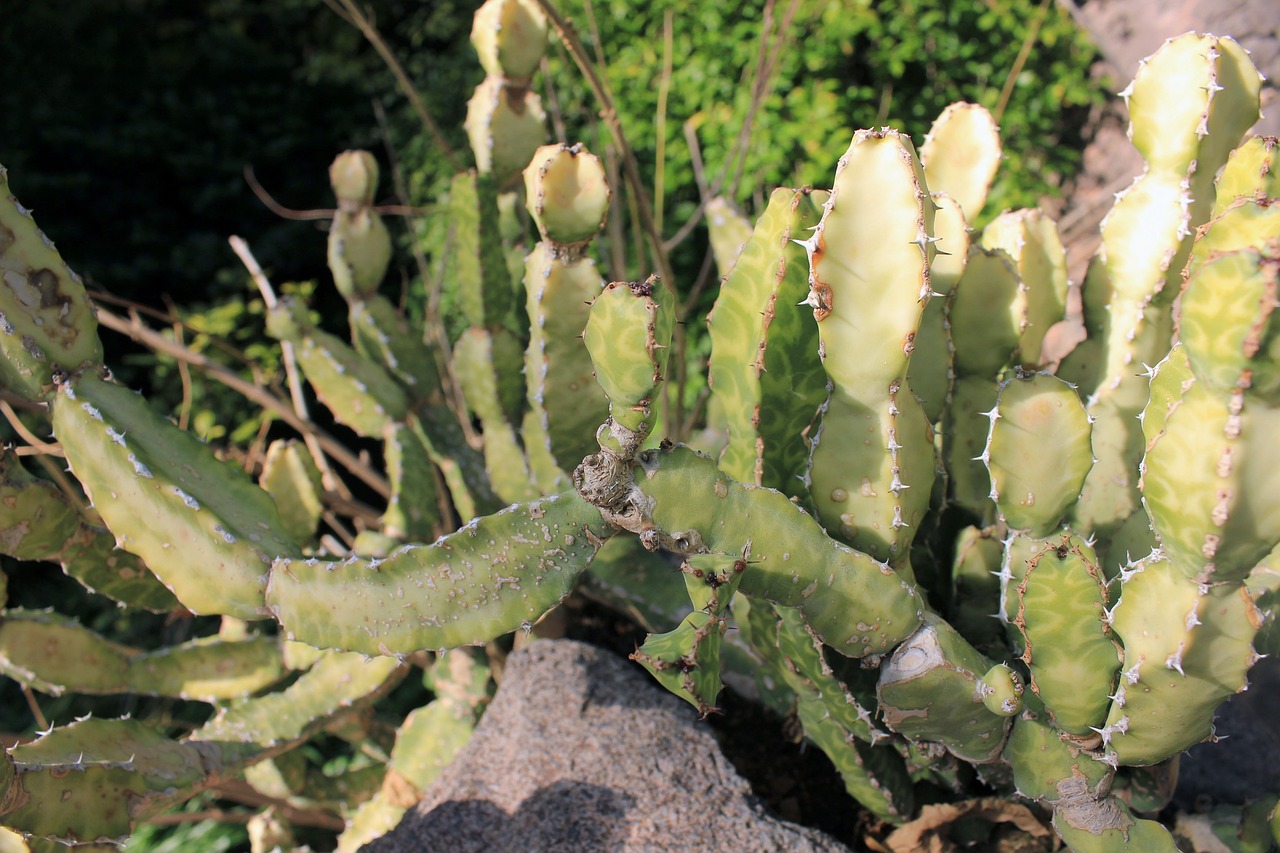HousePlantJoy is supported by our audience. When you purchase through one of our links, we may earn a small affiliate commission. As an Amazon Associate I earn from qualifying purchases. Your cost is not affected.
==================
Introduction to the Zig Zag Cactus
Welcome to the fascinating world of succulents. Today, you’ll take a deep dive into the life of an intriguing specimen – the Zig Zag Cactus. This plant, the fishbone cactus, is a beautiful and exotic addition to any home or garden.
Photo by Goodfreephotos_com on Pixabay
The Zig Zag Cactus, known as Epiphyllum anguliger, is a popular houseplant due to its unique zigzag leaf pattern and charming white blooms. This cactus is an epiphyte, meaning it naturally grows on trees in the wild, deriving its nutrients from the soil, air, rain, and accumulated debris.
Your journey with the Zig Zag Cactus begins here. In this comprehensive guide, you’ll learn everything from understanding its intricate patterns to providing the ultimate care for your cactus. You’ll also discover the different names this mesmerizing succulent goes by.
The Intricate Patterns of the Zig Zag Cactus
The Zig Zag Cactus is a remarkable spectacle due to its intricate leaf patterns. These patterns are not merely aesthetic features but vital in the fish bone cactus’s survival. The zigzag pattern of the leaves helps the plant capture sunlight, which is essential for photosynthesis.
Moreover, the zigzag pattern of the leaves helps the plant to capture rainfall efficiently. This is especially crucial in its natural habitat, where rain is sporadic, and every drop counts. The leaves channel the water toward the plant’s root system, ensuring optimal hydration.
The Zig Zag Cactus’s unique leaf pattern also increases its surface area, enabling more efficient gas exchange. This is particularly essential for a cactus ric rac, as it needs to minimize water loss through transpiration while maximizing carbon dioxide uptake for photosynthesis.
The Different Names for the Zig Zag Cactus:
Fishbone, Ric Rac, and More
The Zig Zag Cactus has many names, each inspired by its unique leaf pattern. The most popular moniker is the fishbone cactus, inspired by its leaves’ resemblance to a fish’s skeleton. The name is descriptive and captures the plant’s exotic and intriguing nature.
Another common name for the Zig Zag Cactus is the Ric Rac Cactus. This name is derived from the zigzagging pattern of the leaves that resemble the decorative trim known as ric rac. Like the trim, the plant’s leaves have a wavy, zigzag pattern that is charming and eye-catching.
While these are the most common names, the plant is also known by other monikers, such as the zig-zag plant, the zig-zag cactus, and the moon cactus. Regardless of the name, this beautiful succulent remains a captivating addition to any plant collection.
Caring for Your Zig Zag Cactus: Comprehensive Guide
Now that you’re familiar with the Zig Zag Cactus and its unique features let’s delve into how you can provide the best care for this plant. Even though it’s a type of cactus, the fishbone cactus has different care needs than its desert-dwelling cousins. Remember, this is an epiphyte and naturally thrives in a humid, tropical environment.
The first step in fishbone cactus care is to ensure it has the right potting mix. The mix should be well-draining and mimic the plant’s natural habitat. A mixture of orchid bark, perlite, and peat moss is often ideal.
Next, pay attention to the watering needs of your Zig Zag Cactus. This plant prefers moist soil but not soggy conditions. Overwatering can lead to root rot, so please allow the soil to dry out between watering sessions.
How to Care for a Fishbone Cactus: Tips and Tricks
Caring for a fishbone cactus doesn’t have to be daunting. With a few tips and tricks, you can ensure your plant thrives. First, please provide your fishbone cactus can access bright, indirect light. Too much direct sunlight can cause leaf burn.
Next, make sure you’re fertilizing your Zig Zag Cactus. Feed your plant with a balanced, water-soluble fertilizer every two weeks during the growing season.
Additionally, maintain a warm temperature for your fishbone cactus. This plant prefers temperatures between 60 to 75 degrees Fahrenheit. Therefore, it’s best to keep it indoors during cold seasons.
Also, the ric rac cactus thrives in humid environments. It needs a humidity level of at least 60%.
Ric Rac Cactus Care: Essential Guidelines
The Ric Rac Cactus, another name for the Zig Zag Cactus, has similar care requirements. Apart from providing the right light, temperature, and watering conditions, there are other guidelines you should follow for optimal ric rac cactus care.
First, give your Ric Rac Cactus enough space. This rapid grower plant can reach up to two feet long. So, please make sure it has enough room to spread out without obstruction.
Secondly, provide adequate humidity. The Ric Rac Cactus is a tropical plant and thrives in humid conditions. Therefore, consider placing it in a bathroom or kitchen, where humidity levels are naturally higher.
Finally, repot your Ric Rac Cactus every two to three years to provide fresh soil and more room for growth.
Growth of the Fishbone Cactus: What to Expect
The fishbone cactus growth rate is relatively fast compared to other cactus species. The plant can reach up to two feet long within a few years. Your fishbone cactus will reward you with its rapid growth and potential blooming with the proper care and conditions.
Fishbone cactus blooms are rare but not impossible. If your plant is mature and well-cared for, it may produce stunning, fragrant flowers that bloom at night. These blooms are usually white with yellow centers and can reach up to eight inches in diameter.
The fishbone cactus’s growth is not limited to its size and blooms. You can also expect new offsets, also known as pups, to sprout from the base of the plant. These offsets can be used for zig zag cactus propagation, allowing you to grow new plants from your existing ones.
Zig Zag Cactus Propagation: Step-by-Step Process
Propagating a Zig Zag Cactus is a simple and rewarding process. Whether a novice or an experienced plant lover, you’ll appreciate zig zag cactus propagation’s simplicity and success rate.
You’ll need a healthy leaf cutting from your Zig Zag Cactus to start the propagation process. Please ensure the cutting is at least a few inches long to increase the chances of successful root development.
Next, allow the cutting to dry out for a few days. This process, callousing, helps prevent rot when the cutting is planted.
Once the cutting has been calloused, plant it in a well-draining potting mix. Water the cutting sparingly until roots begin to develop. This process may take a few weeks, so be patient.
How to Propagate a Ric Rac Cactus Successfully
If you’re looking to propagate a Ric Rac Cactus, the process is similar to that of the Zig Zag Cactus. After all, both names refer to the same beautiful plant.
Please ensure your cutting is taken from a healthy, mature plant for successful propagation. This increases the chances of successful root development.
After the cut is calloused, plant it in a well-draining potting mix. Water sparingly until roots develop.
Finally, place your propagated Ric Rac Cactus in a location with bright, indirect light. Monitor the plant’s progress, and with patience, you’ll have a new Ric Rac Cactus to add to your collection.
Propagating a Zig-Zag Plant: Best Practices
When propagating a zig-zag plant, there are several best practices to follow.
First, Always Use a Sterilized Cutting Tool.
This prevents the spread of diseases and pests. Make sure that your cutting edge is sharp. A dull blade often makes a shredded cut. Making an immaculate cut from your fishbone cactus plant would be best to ensure both the plant and the cutting thrive.
Second, Allow the Cutting Ample Time to Callous.
Rushing this process can lead to rot and unsuccessful propagation. Plants take time to callus. Allowing the needed time helps ensure that your new fishbone cactus thrives.
Third, Ensure the Potting Mix Is Well-Draining.
Like most succulents, the Zig-Zag Cactus is prone to root rot if left in waterlogged soil. Just to let you know, cactus soil should be well-draining. The container needs plenty of drainage holes to allow for drainage.
Lastly, Provide the Right Conditions for Your Propagated Plant.
Adequate light, temperature, and humidity are crucial for successful growth. Growing fishbone cactus need similar lighting and temperatures as adult plants. You might even keep the cutting near the adult ric rac plant.
Fishbone Cactus Propagation in Water:
Detailed Instructions
The fishbone cactus can also be propagated in water for those who prefer water propagation. A cactus in water? Unlike most cacti, the ric rac cactus grows roots in water if done correctly.
The process is quite simple and allows you to observe root growth directly.
Start by taking a healthy cut from your fishbone cactus plant. Let it be callous for a few days.
Then, place the calloused end of the cutting in a container with clean water. Make sure only the cut end is submerged in water.
Change the water every week to prevent the growth of bacteria or mold. Within a few weeks, roots should start to appear.
Once a healthy root system has developed, you can transfer your fishbone cactus to a pot with a well-draining potting mix. Remember to acclimate the plant gradually to its new soil environment to prevent shock.
Enjoying the Beauty and Simplicity of the Zig Zag Cactus
The Zig Zag Cactus is more than just a plant; it’s a captivating piece of nature’s art. With its intricate patterns and charming blooms, it adds a touch of exotic beauty to any space.
Easy to Care For
And the best part? Caring for this plant is as simple as it is rewarding. From understanding its unique needs to propagating new plants, the Zig Zag Cactus offers a delightful journey for any plant lover.
So, why not add a Zig Zag Cactus to your collection? Enjoy the beauty and simplicity of this mesmerizing succulent, and watch as it thrives under your care.
Quick Facts and Tips
- Zig zag cactus (Disocactus anguliger) is a tropical epiphytic cactus native to Mexico.
- It is also known as fishbone, ricrac, orchid cactus.
- Zig zag cactus has long, flattened, deeply serrated stems, giving it a zigzag appearance.
- The stems can grow up to 3 feet long and 6 inches wide.
- Zig zag cactus is a low-maintenance plant that is easy to care for.
- It prefers bright, indirect light and moist, humid conditions.
- Water the plant regularly, but let the soil dry out slightly between waterings.
- Fertilize the plant every few months during the spring and summer with a balanced fertilizer.
- Zig zag cactus blooms in the late summer or fall. The flowers are small and white or yellow.
- Zig zag cactus can be propagated from stem cuttings.
More Care Tips
- Use a well-draining potting mix that is designed explicitly for cacti or succulents.
- Mist the plant regularly to increase humidity. Ric Rac cactus prefers 60% humidity or higher.
- Place the plant in a spot that receives bright, indirect light.
- Repot the plant every 2-3 years or when it outgrows its current pot.
- Please be careful not to overwrite the plant, leading to root rot.
- Watch for pests such as mealybugs and scale.
Unleash the Zig Zag Magic: Embrace Nature’s Elegance with Houseplantjoy!
We have delved into the fascinating world of the Zig Zag Cactus and uncovered its allure that sets it apart in the realm of houseplants. Its mesmerizing zigzag pattern and effortless elegance have left us captivated, proving that nature’s creativity knows no bounds.
As we nurture these remarkable succulents, we not only invite a unique touch of greenery into our homes but also embrace the therapeutic benefits of plant care. The joy of watching the Zig Zag Cactus flourish reminds us of the beauty and resilience of life itself.
If you’re eager to start your own Zig Zag Cactus journey, look no further than Houseplantjoy. Their website offers a bountiful selection of rare and exquisite houseplants, including the Zig Zag Cactus, waiting to grace your living space with their splendor.
So, let the beauty of the Zig Zag Cactus infuse your surroundings with its graceful charm. Head over to Houseplantjoy and begin a rewarding relationship with this remarkable succulent. Let nature’s wonder flourish in your home, one zigzag at a time. Happy planting!
FAQs
How often should I water my Zig Zag Cactus?
Zig Zag Cacti are drought-tolerant plants. Water them sparingly, allowing the soil to dry out between waterings. During active growth in spring and summer, water every 2-3 weeks, and reduce watering to once a month in fall and winter.
Does the Zig Zag Cactus require direct sunlight?
Yes, the Zig Zag Cactus thrives in bright, indirect sunlight. Place it near a sunny window or in a well-lit spot where it can receive several hours of indirect sunlight each day. Avoid placing it in intense, direct sunlight, as it can scorch the plant.
How do I propagate my Zig Zag Cactus?
Propagating the Zig Zag Cactus is relatively easy. You can use stem cuttings to propagate new plants. Simply take a healthy stem cutting, let it callus for a day or two, and then plant it in well-draining cactus or succulent soil mix. Water sparingly and keep the cutting in a warm, bright location. Roots should develop within a few weeks.
? Discover the Green Oasis: Join Us on Social Media! ?
? Explore our official website for fascinating articles, tips, and tricks on plant care and gardening: houseplantjoy.com
? Engage with our thriving community on Facebook: facebook.com/houseplantjoyblog
? Follow us on Instagram for stunning visuals and product reviews: instagram.com/houseplantjoy20
? Get inspired on Pinterest with creative gardening ideas: pinterest.com/houseplantjoy
? Connect on Twitter and stay updated with the latest plant trends: twitter.com/houseplantjoy
? Dive into the plant-loving world of TikTok: tiktok.com/@houseplantjoy
Embrace the joy of plants, share your green journey, and join our passionate community! ???








